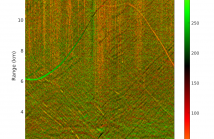- Transducers
- Spatial and Multichannel Audio
- Source Separation and Signal Enhancement
- Room Acoustics and Acoustic System Modeling
- Network Audio
- Audio for Multimedia
- Audio Processing Systems
- Audio Coding
- Audio Analysis and Synthesis
- Active Noise Control
- Auditory Modeling and Hearing Aids
- Bioacoustics and Medical Acoustics
- Music Signal Processing
- Loudspeaker and Microphone Array Signal Processing
- Echo Cancellation
- Content-Based Audio Processing

- Read more about Dominant Component Tracking for Empirical Mode Decomposition using a Hidden Markov Model
- Log in to post comments
It is well known that the empirical mode decomposition algorithm does not always return an appropriate decomposition due to problems like mode mixing. In this paper, we consider the problem of a component being split across several intrinsic mode functions (IMFs). We propose the use of a hidden Markov model (HMM) to track the dominant component across the set of IMFs returned by EMD.
- Categories:
 11 Views
11 Views
- Read more about Rumour Source Detection in Social Networks using Partial Observations
- Log in to post comments
- Categories:
 20 Views
20 Views
- Read more about ELITE GRADIENT DESCENT OPTIMIZATION OF ANTENNA PARAMETERS CONSTRAINED BY RADIO COVERAGE IN GREEN CELLULAR NETWORKS
- Log in to post comments
globalsip.pdf
- Categories:
 4 Views
4 Views
- Read more about A COMPARATIVE STUDY OF FEATURES AND CLASSIFIERS IN SINGLE-CHANNEL EEG-BASED MOTOR IMAGERY BCI
- Log in to post comments
This paper determined the best combination that maximizes the classification accuracy of single-channel electroencephalogram (EEG)-based motor imagery brain–computer interfaces (BCIs). BCIs allow people including completely locked-in patients to communicate with others without actual movements of body. Whereas EEGs are usually observed by multiple electrodes, single-channel measurement has been recently studied for gaining the simplicity of use.
- Categories:
 54 Views
54 Views
- Read more about A COMPARATIVE STUDY OF FEATURES AND CLASSIFIERS IN SINGLE-CHANNEL EEG-BASED MOTOR IMAGERY BCI
- Log in to post comments
This paper determined the best combination that maximizes the classification accuracy of single-channel electroencephalogram (EEG)-based motor imagery brain–computer interfaces (BCIs). BCIs allow people including completely locked-in patients to communicate with others without actual movements of body. Whereas EEGs are usually observed by multiple electrodes, single-channel measurement has been recently studied for gaining the simplicity of use.
- Categories:
 6 Views
6 Views
- Read more about What matters the most? Optimal Quick Classification of Urban Issue Reports by Importance
- Log in to post comments
Civic engagement platforms such as SeeClickFix and FixMyStreet have revolutionized the way citizens interact with local governments to report and resolve urban issues. However, recognizing which urban issues are important to the community in an accurate and timely manner is essential for authorities to prioritize important issues, allocate resources and maintain citizens’ satisfaction with local governments.
SCC_Final.pdf
- Categories:
 56 Views
56 Views
- Read more about Quickest Freeway Accident Detection Under Unknown Post–Accident Conditions
- Log in to post comments
Accurate traffic accident detection is crucial to improving road safety conditions and route navigation, and to making informed decisions in urban planning among others. This paper proposes a Bayesian quickest change detection approach for accurate freeway accident detection in near–real–time based on speed sensor readings. Since post–accident conditions are hardly known, a maximum likelihood method is devised to track the relevant unknown parameters over time. Four aggregation schemes are designed to exploit the spatial correlation among sensors.
- Categories:
 41 Views
41 Views
- Read more about Sub-Bands Beam-Space Adaptive Beamformer for Port-Starboard Rejection in Triplet Sonar Arrays
- Log in to post comments
This work addresses the problem of Port-Starboard (PS) beamforming for low-frequency active sonar (LFAS) with a triplet receiver array.
The work presents a new algorithm for sub-bands beam-space adaptive beamforming with twist compensation and evaluates its performance with experimental data collected at sea.
- Categories:
 66 Views
66 Views
- Read more about Increasingly specialized ensemble of Convolutional Neural Networks for Fine-grained recognition
- Log in to post comments
Fine-grained recognition focuses on the challenging task of automatically identifying the subtle differences between similar categories. Current state-of-the-art approaches require elaborated feature learning procedures, involving tuning several hyper-parameters, or rely on expensive human annotations such as objects or parts location. In this paper we propose a simple method for fine-grained recognition that exploits a nearly cost-free attention-based focus operation to construct an ensemble of increasingly specialized Convolutional Neural Networks.
simonelli.pdf
- Categories:
 28 Views
28 Views
- Read more about An Interior Point Method for Nonnegative Sparse Signal Reconstruction
- Log in to post comments
We present a primal-dual interior point method (IPM) with a novel preconditioner to solve the ℓ1-norm regularized least square problem for nonnegative sparse signal reconstruction. IPM is a second-order method that uses both gradient and Hessian information to compute effective search directions and achieve super-linear convergence rates. It therefore requires many fewer iterations than first-order methods such as iterative shrinkage/thresholding algorithms (ISTA) that only achieve sub-linear convergence rates.
- Categories:
 12 Views
12 Views